All Management Events
- Dr Syed Tajammul Ahmad September 26, 2022
- Education fair 2022: An exposure to major USA and UK universities September 26, 2022
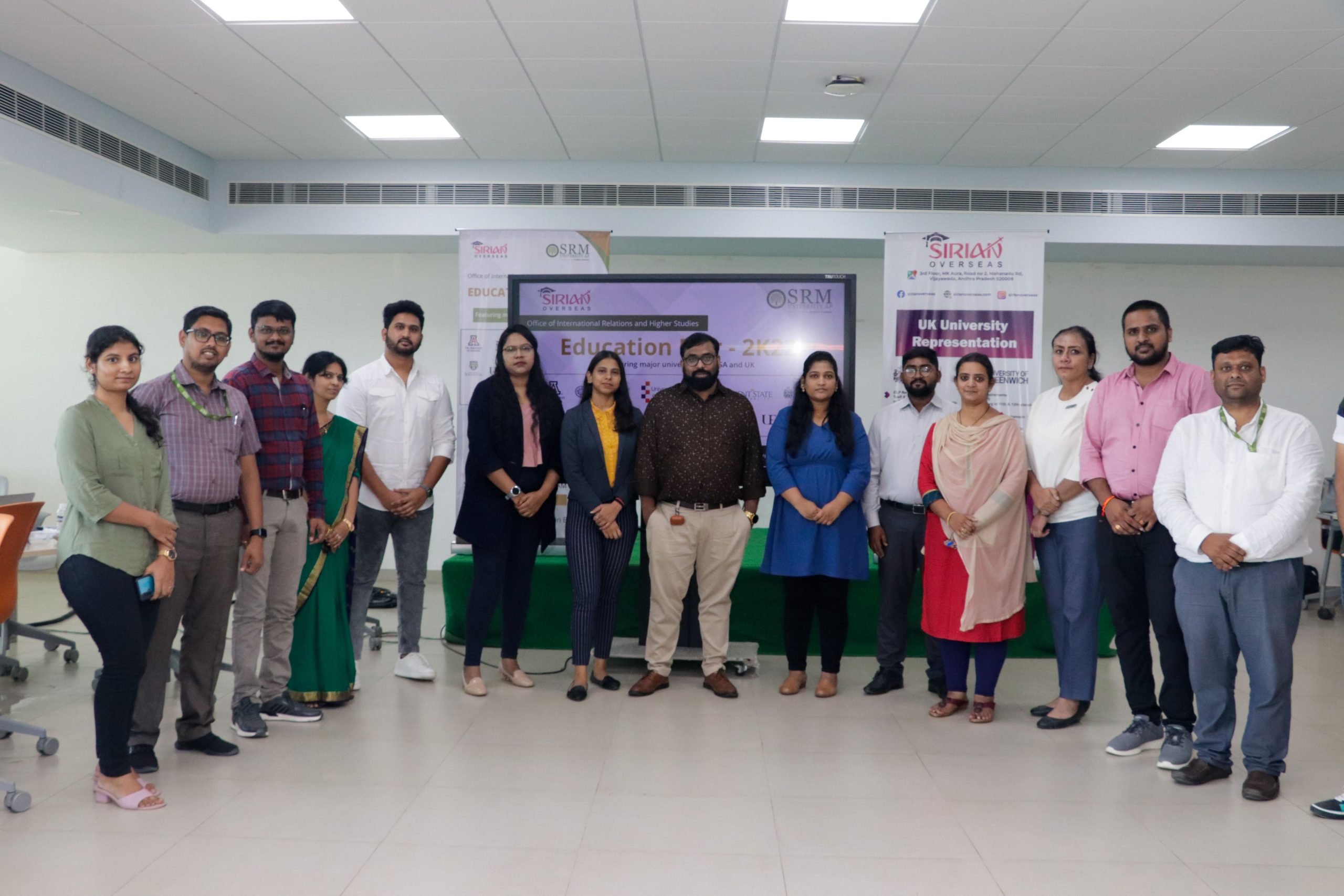 The office of International Relations and Higher Studies hosted the Education Fair on Friday, September 23, 2022, to provide thorough guidance about the higher education universities and programmes available across the globe. The event featured major USA and UK universities, including the University of Rochester, USA, University of Greenwich, UK, University of Essex, UK, University of Arizona, USA, and many more.
The office of International Relations and Higher Studies hosted the Education Fair on Friday, September 23, 2022, to provide thorough guidance about the higher education universities and programmes available across the globe. The event featured major USA and UK universities, including the University of Rochester, USA, University of Greenwich, UK, University of Essex, UK, University of Arizona, USA, and many more.The education fair began with an introduction to study abroad programmes. Students witnessed a detailed PowerPoint presentation on the general aspects of higher education abroad, like the qualifying examinations, VISA, various coaching available, fee waivers, etc. The education fair was conducted to give the students accurate information from the streams they want to choose to the scopes of that streams in a particular state or country.
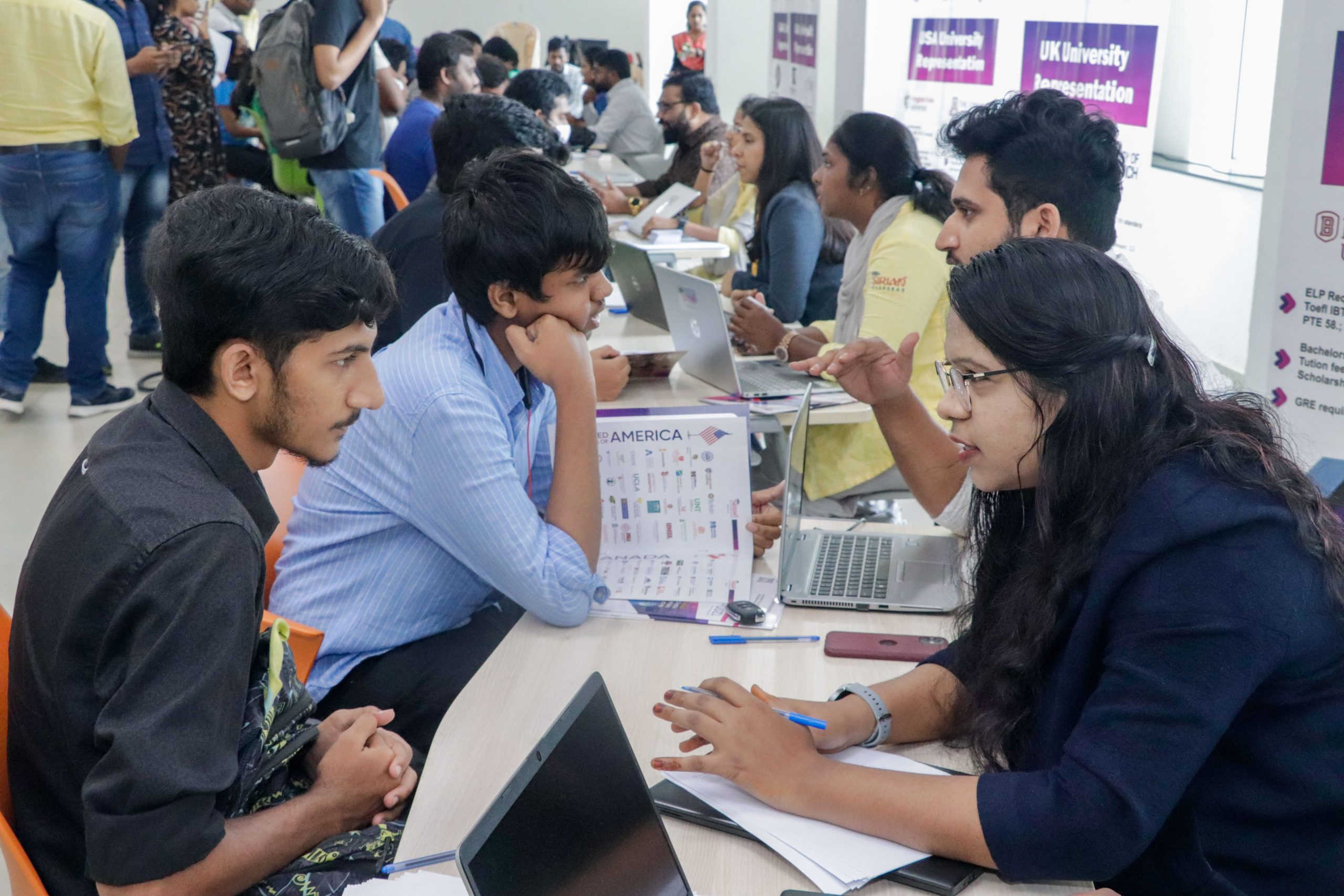 Roop Sagar from BTech CSE also expressed how he had no clarity about the processes, requirements, scholarships, etc., before attending such sessions and was able to get a good picture of his aspirations after interacting with the university representatives. He recollected how the Office of International Relations and Higher Studies has always assisted him with accurate guidance whenever he was in doubt.
Roop Sagar from BTech CSE also expressed how he had no clarity about the processes, requirements, scholarships, etc., before attending such sessions and was able to get a good picture of his aspirations after interacting with the university representatives. He recollected how the Office of International Relations and Higher Studies has always assisted him with accurate guidance whenever he was in doubt.“As someone who wants to pursue higher education by specialising in AI and ML, I am thankful to SRM University- AP for giving exposure to foreign universities that offer affordable courses and internships,” said Yaswanth from BTech CSE as he shared thoughts on the Education Fair.
The representatives of the universities were in awe of students who had done their homework beforehand of the event and were pleased to answer as many questions as possible. “SRM University is one of the leading universities in India, there is no doubt about that, and here we get many students who are extremely talented and are suitable for post-graduation programmes and research,” said Amritpal Kaur, Senior Programme Officer of the University of Rochester.
Continue reading → - An incredible journey to the India Book of Records September 26, 2022
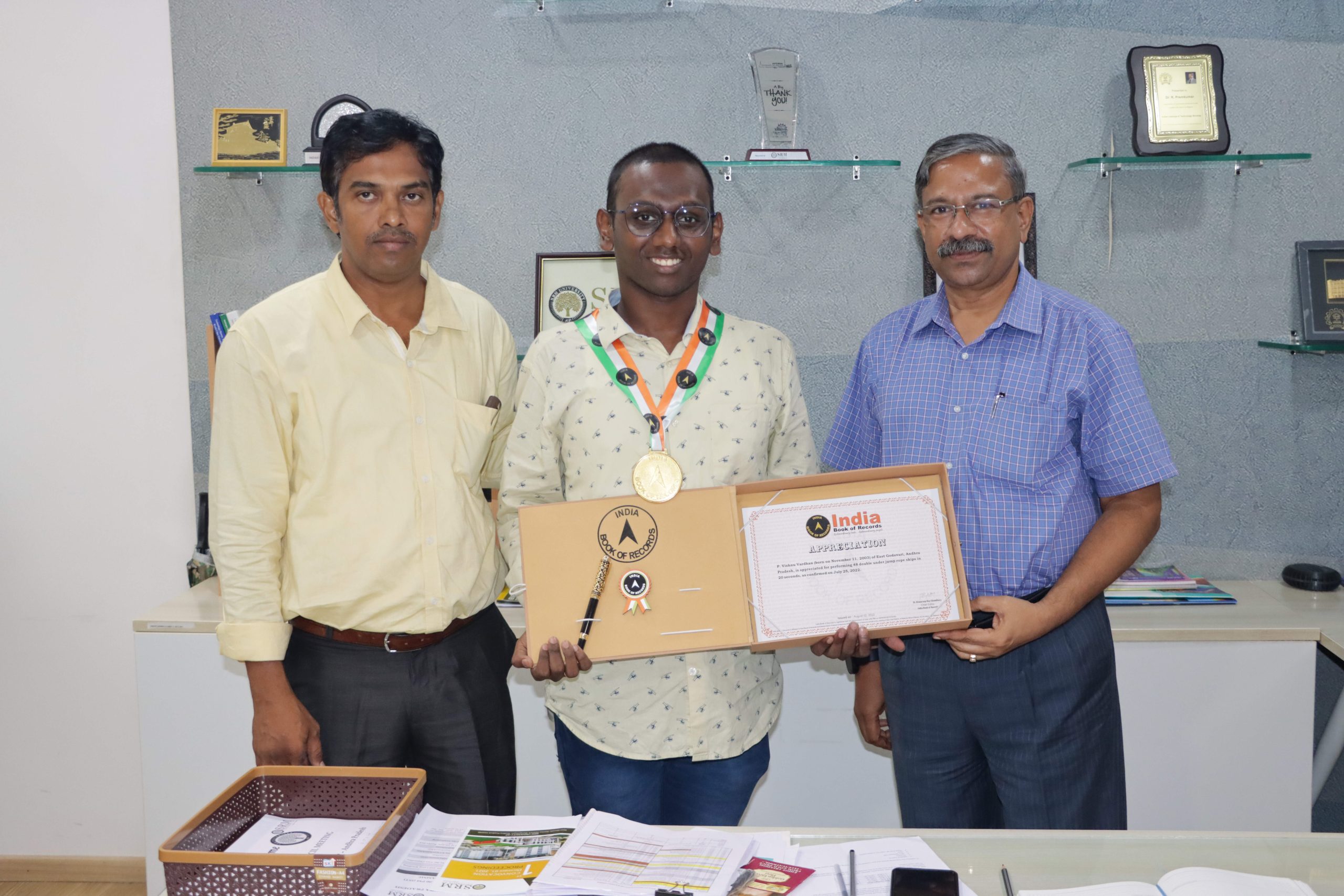
It is a moment of immense pride for SRM University- AP to welcome a new record maker into our midst. P Vishnu Vardhan from the Department of Computer Science Engineering has carved his name into the India Book of Records for performing 48 double-under jump rope skips in 20 seconds. He has also managed to set two records in the National Book of World Records. When most surrender their favourite hobbies to the rush of our work and academic life, this incredible student has displayed hardwork and dedication to transform his hobby into a national record.
Mr Vishnu Vardhan comments on the multiple times he succumbed to giving up his hobby of skipping ropes but realised that it was a space of refuge amidst the pressures of the world. He has shown an incredible feat of courage and dedication to set this impressive record by braving the rejection that he initially had faced.
“When I came to know about the India Book of Records, it was my parents who made me apply for it but I was rejected the first time. I had lost all hope but my friends supported me to pursue my passion for skipping rope and also helped with my academics. Finally I have entered into the National Book of Records, twice and the India Book of Records as well”, he said.
He has extended a heartfelt note towards his parents and his friends, M Surya Teja and K Nithin, for their undying support and confidence that has guided him to attain this amazing achievement.
Mr Vishnu Vardhan hopes to represent SRM University- AP at the All India Inter University rope skipping competition and provide further laurels for the institution. His journey to setting national records proves that with passion, endurance and a generous amount of optimism, even the unachievable could be achieved.
Continue reading → - Awareness on international internships and immersion programmes September 26, 2022
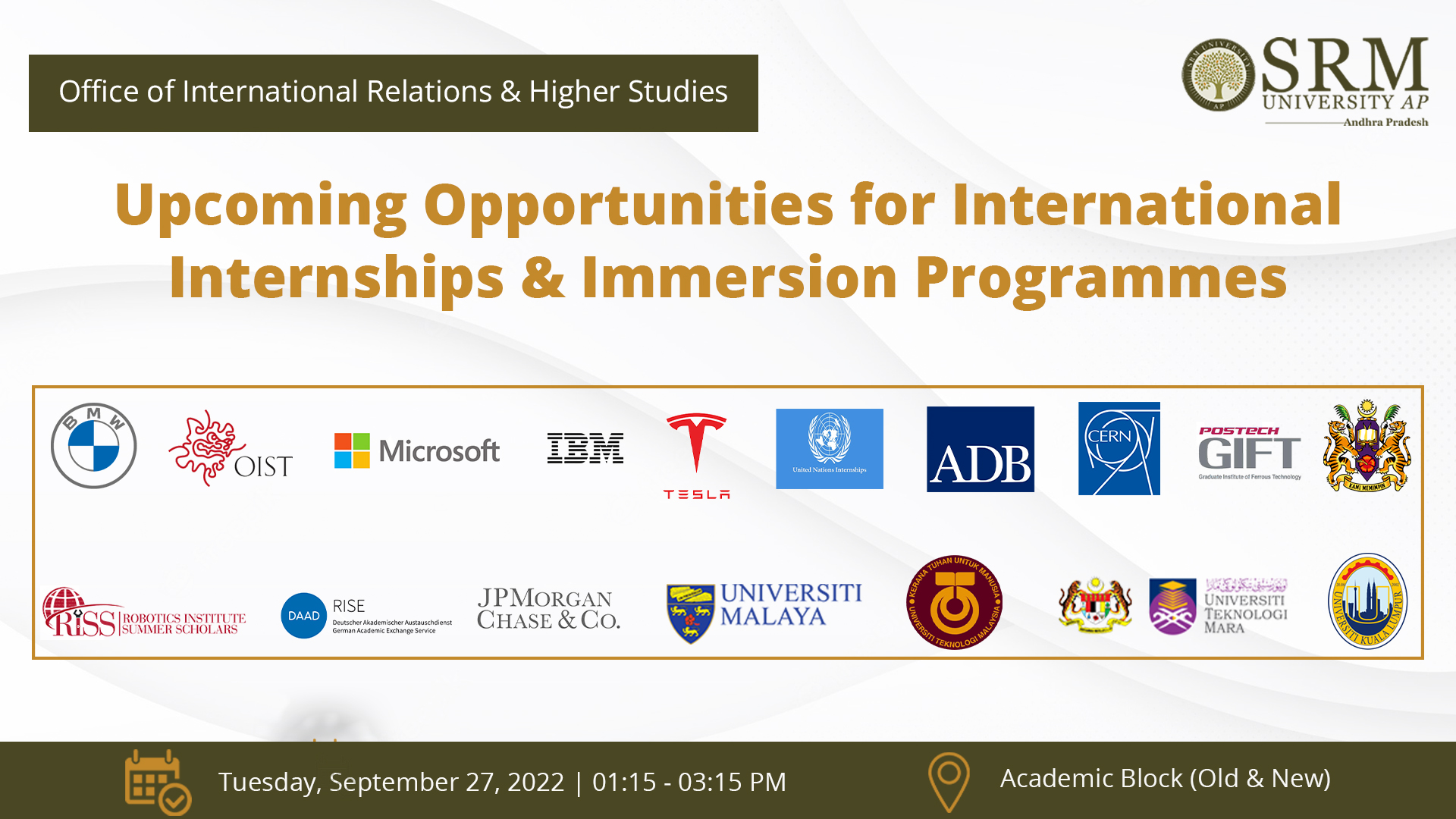
Students are often confused about choosing the right course to attain their dream career. The International Internship and Immersion Programmes enlighten students with the multitude of courses and internships that are at their disposal. The programme guides students on opting the right course beneficial for their future career of choice.
The Office of International Relations and Higher Studies is conducting an awareness programme called Upcoming Opportunities for International Internships & Immersion Programmes for interested students. This initiative provides insight on the preparatory strategy and process for internships and courses at international universities.
Date: 27 September, 2022
Time: 1.15 PM to 3 .15 PM IST
Location: Academic Block (Old & New), Ground Floor
Join the event and initiate your step to global education.
Continue reading → - Students visit Fopple Drone Tech Pvt Ltd September 26, 2022
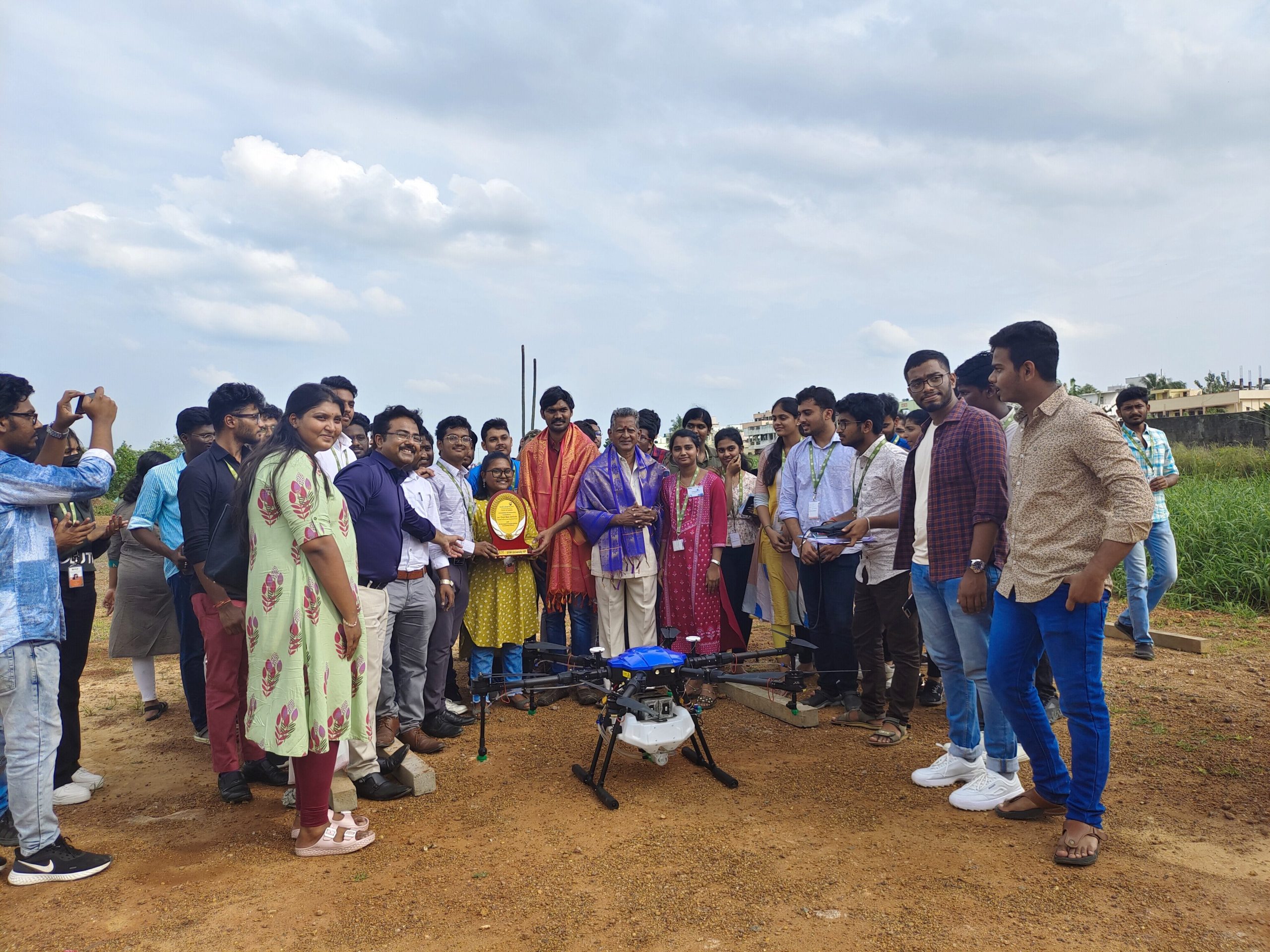
The Directorate of Entrepreneurship and Innovation had conducted an industry visit to Fopple Drone Tech Pvt Ltd, an innovative start-up aiming to revolutionise agricultural machinery. The industry visit that took place on September 20, 2022 was organised by the student community Industree Owl from the Home of Leaders initiative.The participants had the chance to experience the latest drone technology and its various applications in the agricultural industry.
The learning process is never restricted to purely theoretical bounds but associated as being an exploratory and experiential activity. The startup/industrial visit provided students practical exposure to a startup as well as its challenges and first hand experience of what it takes to be a leader, a startup founder or an entrepreneur.
As a part of their visit, the students participated in a boot camp followed by an intense interaction with the farmer community to identify and understand the grassroot problems and the application of technology as a solution. Later, Shri Gopi Raja, the CEO and founder of Fopple Drone Tech Pvt. Ltd addressed the participants and shared his journey to innovation which made a deep impact on the students.The visit came to fruitful end inspiring courage among students to expand their vision and realise their potential to work in the direction of obtaining Atmanirbhar Bharat.
The industrial visit had intended to design a solution and instil inspiration in students to begin a venture in the same domain. After acquiring necessary perceptive, students have reached out to discuss their project ideas which can be commercialised to utilise in the advancement in the field of agriculture. The visit granted a brilliant and insightful exposure to our students on the cutting-edge technology, the scope and the future of India in the next 5 -10 years.
Continue reading → - Applications of federated learning in computing technologies September 26, 2022
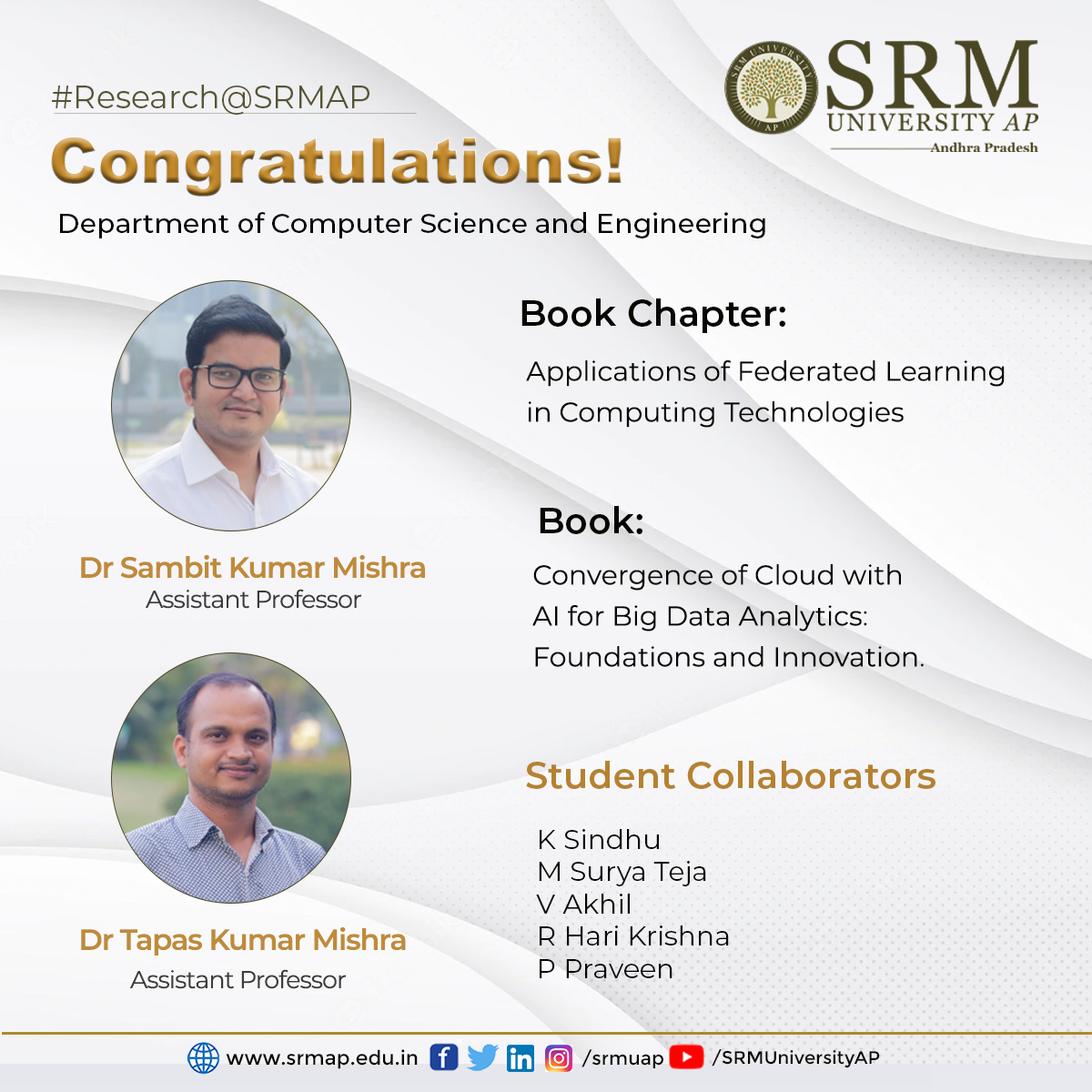
The Department of Computer Science and Engineering is delighted to announce that Assistant Professors, Dr Sambit Kumar Mishra and Dr Tapas Kumar Mishra, and the final year BTech students – Kotipalli Sindhu, Mogaparthi Surya Teja, Vutukuri Akhil, Ravella Hari Krishna, and Pakalapati Praveen – published a chapter titled Applications of Federated Learning in Computing Technologies in the scopus-indexed book titled Convergence of Cloud with AI for Big Data Analytics: Foundations and Innovation, a Wiley publication.
The book chapter describes the application of federated learning to various computing technologies. The federated learning concept is similar to the client-server model, where the client sends data to the server for processing and the processed data is again sent to the client. But, in federated learning, the clients are allowed separately to teach the deep neural network models with the local data combined with the deep neural network model at the central server.
Federated learning is a machine learning technique that trains the knowledge across different decentralized devices holding samples of information without exchanging them. The concept is additionally called collaborative learning. Researchers have used large frameworks for all the computations in the past years, and then they have moved to client-server frameworks.
It is also like a traditional centralised machine learning technique. All the local datasets are uploaded to a minimum of one server, so it assumes that local data samples are identically distributed. Because of its security and privacy concerns, it’s widely utilised in many applications like IoT, cloud computing; Edge computing, Vehicular edge computing, and many more. In the chapter, different applications of federated learning, their privacy concerns, and their definition in various fields of computing technologies like IoT, Edge Computing, Cloud Computing, Vehicular edge computing, etc. are presented. It will be of advantage to graduate students, researchers, academicians, institutions, and professionals that are interested in exploring the areas of intelligent computing systems.
- Industry project sanctioned to Prof G S Vinod Kumar September 23, 2022
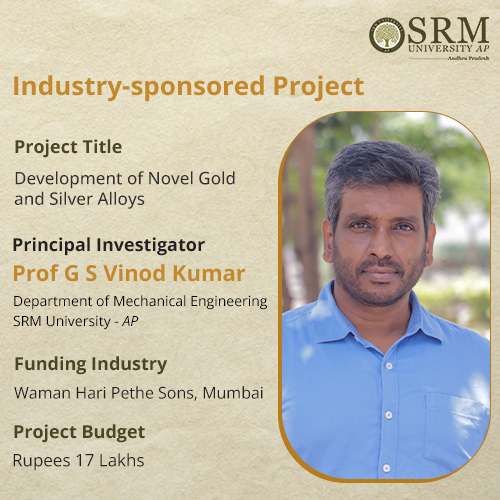
The research project titled Development of Novel Gold and Silver Alloys was sanctioned to Prof G S Vinod Kumar from the Department of Mechanical Engineering. The project was sanctioned by Waman Hari Pethe Sons, a leading Gold/Diamond jewellery manufacturing company based in Maharashtra, with a total outlay of Rupees 17 Lakhs. The tenure of the project is two years, from May 2022 to May 2024.
Prof Vinod Kumar’s research interests mainly revolve around the hardening of 22 carats and 24 carats gold for light-weight and high-strength jewellery and the novel processing of light alloy (Al and Mg) foam and studying the structure and properties. He has been intensely involved in the development of technologies for improving the hardness of 22k gold for weight saving and high strength in the cast and hand-made jewellery. This was jointly patented by SRM and Titan. He also has several industrial research partnerships and funded projects to his credit.
The present project aims to develop novel high carat gold (24,22 and 18 carats) for high-strength and light-weight jewellery applications and novel silver alloys (high pure (99%) or sterling silver (92.5%)) having better anti-tarnishing capability. It further aims to develop colour gold alloys (Black, violet and pink gold). The project also involves both the lab-scale and industrial development of the process for scaling up jewellery production of the gold and silver alloys.
- Blockchain Technology and its applications. September 22, 2022
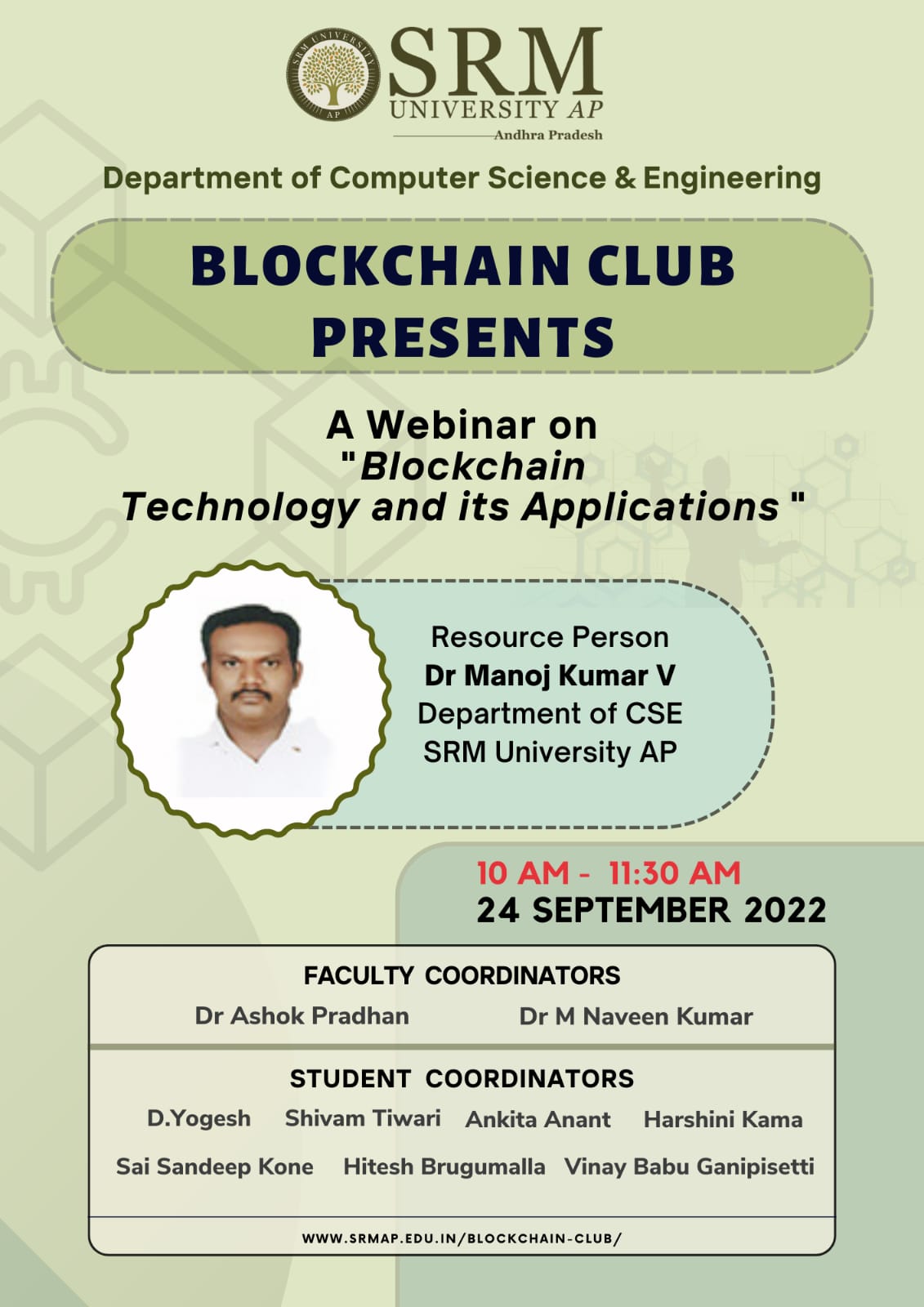 Blockchain is a digital ledger of any transactions or contracts that need to be independently recorded. This technology underpins digital currency transactions. It can be utilised in many industries, including Financial Services, Healthcare, Government, Travel and Hospitality, and many more. The Blockchain club of the Department of Computer Science and Engineering is hosting a webinar on Blockchain Technology and its applications.
Blockchain is a digital ledger of any transactions or contracts that need to be independently recorded. This technology underpins digital currency transactions. It can be utilised in many industries, including Financial Services, Healthcare, Government, Travel and Hospitality, and many more. The Blockchain club of the Department of Computer Science and Engineering is hosting a webinar on Blockchain Technology and its applications.Date: September 24, 2022
Time: 10.00 AM to 11.30 AM
Assistant Prof Dr Manoj Kumar V of the Department of Computer Science and Engineering, will handle the session. More than 130 participants will be attending the programme.
About the speaker
Dr Manoj Kumar V did his PhD from NIT Tiruchirappalli. He has teaching experience at VIT- AP university, Anjalai Ammal Mahalingam Engineering College, Tamil Nadu, and Mount Zion College of Engineering and Technology, Tamil Nadu. Internet of Things, Blockchain, and Cryptocurrency are his primary research interests.
Click here to join the webinar!
Continue reading → - Highly-stable amine-free CsPbBr3 PNCs for display applications September 22, 2022

The Department of Chemistry is glad to announce that Dr Nimai Mishra, Assistant Professor, along with his research group comprising PhD scholars, Syed Akhil, Manoj Palabathuni, Subarna Biswas, Rahul Singh, have published an article titled Highly-Stable Amine-Free CsPbBr3 Perovskite Nanocrystals for Perovskite-Based Display Applications in the journal ACS Applied Nano Materials published by the American Chemical Society, having an impact factor of 6.14.
Colloidally synthesised cesium lead halide (CsPbX3; X=Cl, Br, and I) perovskite nanocrystals (PNCs) often suffer from poor ambient and environmental stability conditions, limiting their practical applications. The commonly used surfactant oleylamine is converted to oleylammonium cation, which pulls out the halide anion from the PNCs surface, thus disrupting the nanocrystal’s structural integrity and stability.
The research group has developed a simple, completely amine-free colloidal synthesis with a hot injection method in open-atmospheric conditions and introduced bromooctane as a bromine precursor to overcome the above issues. These, as synthesized amine-free PNCs, showed a photoluminescence quantum yield (PLQY) of around 60 %, and the size of PNCs is ~25 nm. Moreover, these amine-free PNCs were highly stable in the colloidal solution and thin films for more than five months in ambient conditions, with 66% of its initial PLQY.
In addition, these PNCs have shown exceptional stability under different environmental conditions, with 44 % of initial PL even after 6 hours of water treatment and 28 % of initial PL under ethanol treatment for 120 minutes. Furthermore, it has exhibited excellent photostability for 96 hours and retained 36 % of its initial PL under ceaseless UV light irradiation at 365 nm (8 W/cm2). Additionally, these PNCs have good stability upon heat treatment and maintained 34 % of initial PL upon heating up to 90 ºC.
The research team has also successfully fabricated the green-emitting down-conversion LED using these amine-free PNCs. Thus, they visualize that these amine-free CsPbBr3 PNCs are perhaps the ideal candidates for perovskite-based display applications.
Continue reading →
- Molecular design to store solar energy September 22, 2022
 India has an ambitious target of achieving 300 GW of solar power by 2030. Conventional methods for producing solar power involve absorbing sunlight by a molecule and converting it directly into electricity. This is possible only during the daytime when sunlight is available. An interesting and complementary prospect is storing the absorbed solar energy by converting it into a different form of energy, such as chemical energy, which can then be transformed into electrical energy when sunlight is not available during the night-time.
India has an ambitious target of achieving 300 GW of solar power by 2030. Conventional methods for producing solar power involve absorbing sunlight by a molecule and converting it directly into electricity. This is possible only during the daytime when sunlight is available. An interesting and complementary prospect is storing the absorbed solar energy by converting it into a different form of energy, such as chemical energy, which can then be transformed into electrical energy when sunlight is not available during the night-time.To realise this prospect, Assistant Professor Dr Baswanth Oruganti from the Department of Chemistry has designed a molecule that can absorb solar energy and convert it into the chemical energy of the bonds. His paper titled Modulating the Photocyclization Reactivity of Diarylethenes through Changes in the Excited-State Aromaticity of the π-Linker has been published in the Journal of Organic Chemistry, on Cover Page, with an impact factor of 4.2. He is both the first author as well as the corresponding author of the article. For this project, he has collaborated with Prof Bo Durbeej, Division of Theoretical Chemistry, Department of Physics, Chemistry, and Biology (IFM), Linköping University, Sweden.
Abstract
In recent years, the concept of excited-state aromaticity and its applications in photophysics and photochemistry has attracted considerable research interest. Our study uses quantum chemical calculations to systematically investigate if the photocyclization reactivity of diarylethene switches can be controlled by the excited-state aromaticity of the ethene bridge. Indeed, we demonstrate that these switches can be transformed from being highly reactive to completely non-reactive by changing the excited-state character of the bridge from anti-aromatic to aromatic.
Generally, molecules tend to move from a high-energy state to a low-energy state, as the lowering of energy increases the stability of the molecule and makes it chemically less reactive. In contrast, the present study shows that it is possible to chemically transform a molecule from a low-energy (aromatic) state to a high-energy (non-aromatic) state by absorption of light. This reaction occurs via a high-energy (anti-aromatic) electronically excited state of the molecule induced by light and has potential applications for storing solar energy in the form of chemical energy.
One challenge in the design of molecular solar energy storage systems, such as the diarylbenzene designed in the study, is that it is difficult to store solar energy for a longer period due to the instability of the newly formed chemical bonds at room temperature. To store solar energy for a longer period, one needs to compromise on the amount of energy stored in the bonds. In this regard, in the future, researchers are planning to optimise their molecular design by finding the right balance between the amount of solar energy stored and the time period for which it can be stored.
Continue reading →

